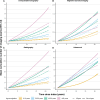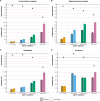Medical imaging utilization in migrants compared with nonmigrants in a universal healthcare system: A population-based matched cohort study
- PMID: 39437267
- PMCID: PMC11495850
- DOI: 10.1371/journal.pmed.1004474
Medical imaging utilization in migrants compared with nonmigrants in a universal healthcare system: A population-based matched cohort study
Abstract
Background: Medical imaging is an integral part of healthcare. Globalization has resulted in increased mobilization of migrants to new host nations. The association between migration status and utilization of medical imaging is unknown.
Methods and findings: A retrospective population-based matched cohort study was conducted in Ontario, Canada from April 1, 1995 to December 31, 2016. A total of 1,848,222 migrants were matched 1:1 to nonmigrants in the year of migration on age, sex, and geography. Utilization of computed tomography (CT), magnetic resonance imaging (MRI), radiography, and ultrasonography was determined. Rate differences per 1,000 person-years comparing migrants to nonmigrants were calculated. Relative rates were calculated using a recurrent event framework, adjusting for age, sex, and time-varying socioeconomic status, comorbidity score, and access to a primary care provider. Estimates were stratified by migration age: children and adolescents (≤19 years), young adults (20 to 39), adults (40 to 59), and older adults (≥60). Utilization rates of CT, MRI, and radiography were lower for migrants across all age groups compared with Ontario nonmigrants. Increasing age at migration was associated with larger differences in utilization rates. Older adult migrants had the largest gap in imaging utilization. The longer the time since migration, the larger the gap in medical imaging use. In multivariable analysis, the relative rate of imaging was approximately 20% to 30% lower for migrants: ranging from 0.77 to 0.88 for CT and 0.72 to 0.80 for MRI imaging across age groups. Radiography relative rates ranged from 0.84 to 0.90. All migrant age groups, except older adults, had higher rates of ultrasonography. The indication for imaging was not captured, thus it was not possible to determine if the imaging was necessary.
Conclusions: Migrants utilized less CT, MRI, and radiography but more ultrasonography. Older adult migrants used the least amount of imaging compared with nonmigrants. Future research should evaluate whether lower utilization is due to barriers in healthcare access or health-seeking behaviors within a universal healthcare system.
Copyright: © 2024 Di Giuseppe et al. This is an open access article distributed under the terms of the Creative Commons Attribution License, which permits unrestricted use, distribution, and reproduction in any medium, provided the original author and source are credited.
Conflict of interest statement
The authors have declared that no competing interests exist.
Figures



Similar articles
-
Trends in Use of Medical Imaging in US Health Care Systems and in Ontario, Canada, 2000-2016.JAMA. 2019 Sep 3;322(9):843-856. doi: 10.1001/jama.2019.11456. JAMA. 2019. PMID: 31479136 Free PMC article.
-
Long-term medical imaging use in children with central nervous system tumors.PLoS One. 2021 Apr 21;16(4):e0248643. doi: 10.1371/journal.pone.0248643. eCollection 2021. PLoS One. 2021. PMID: 33882069 Free PMC article.
-
Trends in Medical Imaging During Pregnancy in the United States and Ontario, Canada, 1996 to 2016.JAMA Netw Open. 2019 Jul 3;2(7):e197249. doi: 10.1001/jamanetworkopen.2019.7249. JAMA Netw Open. 2019. PMID: 31339541 Free PMC article.
-
Inequalities in health care utilization among migrants and non-migrants in Germany: a systematic review.Int J Equity Health. 2018 Nov 1;17(1):160. doi: 10.1186/s12939-018-0876-z. Int J Equity Health. 2018. PMID: 30382861 Free PMC article.
-
Migration and health: exploring the role of migrant status through register-based studies.Dan Med J. 2015 Apr;62(4):B5068. Dan Med J. 2015. PMID: 25872539 Review.
References
-
- Feliciano C. Immigrant Selectivity Effects on Health, Labor Market, and Educational Outcomes. Annu Rev Sociol. 2020;46(1):315–34. doi: 10.1146/annurev-soc-121919-054639 - DOI
Publication types
MeSH terms
Grants and funding
LinkOut - more resources
Full Text Sources
Miscellaneous

